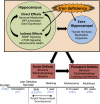The role of iron in learning and memory
- PMID: 22332040
- PMCID: PMC3065765
- DOI: 10.3945/an.110.000190
The role of iron in learning and memory
Abstract
Iron deficiency (ID) is the most common nutrient deficiency, affecting 2 billion people and 30% of pregnant women and their offspring. Early life ID affects at least 3 major neurobehavioral domains, including speed of processing, affect, and learning and memory, the latter being particularly prominent. The learning and memory deficits occur while the infants are iron deficient and persist despite iron repletion. The neural mechanisms underlying the short- and long-term deficits are being elucidated. Early ID alters the transcriptome, metabolome, structure, intracellular signaling pathways, and electrophysiology of the developing hippocampus, the brain region responsible for recognition learning and memory. Until recently, it was unclear whether these effects are directly due to a lack of iron interacting with important transcriptional, translational, or post-translational processes or to indirect effects such as hypoxia due to anemia or stress. Nonanemic genetic mouse models generated by conditionally altering expression of iron transport proteins specifically in hippocampal neurons in late gestation have led to a greater understanding of iron's role in learning and memory. The learning deficits in adulthood likely result from interactions between direct and indirect effects that contribute to abnormal hippocampal structure and plasticity.
Conflict of interest statement
Author disclosures: S. J. B. Fretham, E. S. Carlson, and M. K. Georgieff, no conflicts of interest.
Figures




References
-
- Morris SS, Cogill B, Uauy R. Effective international action against undernutrition: why has it proven so difficult and what can be done to accelerate progress? Lancet. 2008;371:608–21 - PubMed
-
- Dobbing J, Sands J. Comparative aspects of the brain growth spurt. Early Hum Dev. 1979;3:79–83 - PubMed
-
- Le NT, Richardson DR. The role of iron in cell cycle progression and the proliferation of neoplastic cells. Biochim Biophys Acta. 2002;1603:31–46 - PubMed
-
- Kretchmer N, Beard JL, Carlson S. The role of nutrition in the development of normal cognition. Am J Clin Nutr. 1996;63:S997–1001 - PubMed

